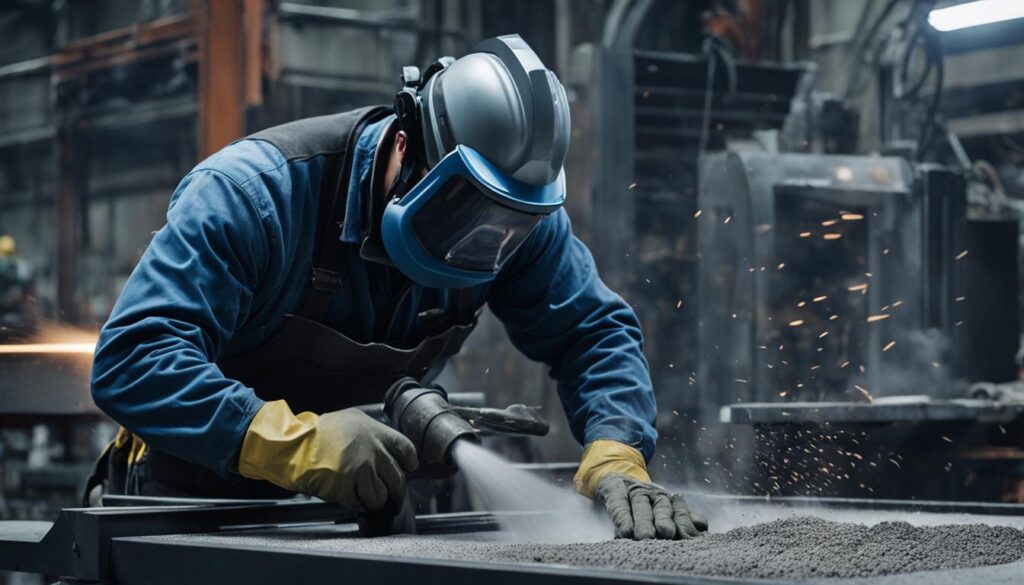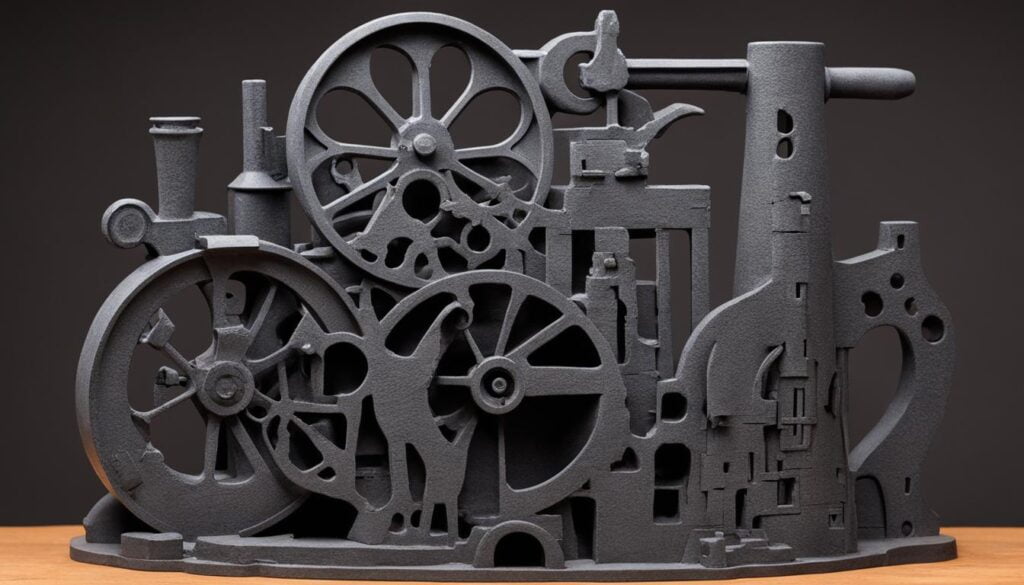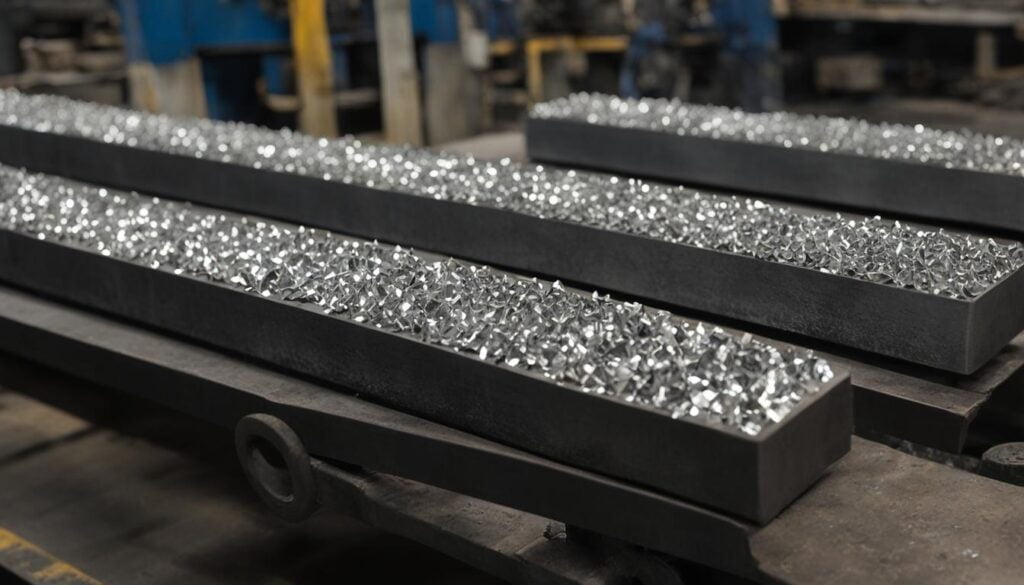Gray iron castings, utilized by KT-Foundry, are integral in the manufacturing of components that require high durability and precision. The process begins with pouring molten iron alloys into molds, followed by a series of machining and finishing techniques to achieve the desired structural integrity and surface quality. Machining involves cutting and shaping the casting to precise dimensions, while finishing encompasses a variety of treatments and coatings to enhance performance characteristics. These steps are crucial for producing components such as valves, engine blocks, brake drums, pump housings, and other items requiring high thermal conductivity and excellent damping capability.
Key Takeaways
- Gray iron castings are vital for manufacturing durable and precise components.
- Machining and finishing techniques ensure structural integrity and surface quality.
- Components produced include valves, engine blocks, brake drums, and pump housings.
- Gray iron castings are known for their high thermal conductivity and damping capabilities.
- KT-Foundry specializes in gray iron castings, offering unique expertise in their production.
The Importance of Machining in Grey Iron Castings
At KT-Foundry, we understand the crucial role that precision machining plays in the production of cast iron components. Machining ensures that each high-performance part meets stringent design specifications and tolerances. Grey iron’s outstanding machinability stems from the presence of graphite in its microstructure, facilitating efficient and precise cutting processes. This capability becomes particularly important for products that require complex geometries and smooth finishes.
As grey iron cannot be forged or extruded, the machining process takes paramount importance in attaining the high tensile strength and detailed features necessary for diverse industrial applications. To showcase the vital aspects of grey iron machining, we have provided an overview of some key benefits:
- Efficient and precise cutting processes
- Production of complex geometries with smooth finishes
- Optimization of mechanical properties
- Improved control over material waste and production costs
KT-Foundry is dedicated to producing exceptional cast iron products by investing in the latest machining technologies and employing expert technical staff. This commitment sets us apart in our ability to deliver components that exceed customer expectations and perform effectively in their intended applications.
Understanding the Finishing Process for Gray Iron Castings
In the production of precision cast iron components, the finishing process is a critical step to ensure that the gray iron castings possess the desired surface quality and protection. This process is composed of various stages such as surface treatments, deburring, and automated finishing systems. These stages play a vital role in enhancing the durability of the gray iron castings and maintaining a consistent quality across all pieces.

Surface Treatments & Coating Techniques
Surface finishing is essential for providing protective layers on gray iron castings, thereby improving their wear resistance and longevity in aggressive environments. Some of the coating applications used in the finishing process include painting, plating, and specialized industrial coatings. These coatings not only enhance durability, but also ensure an improved performance throughout the lifespan of the cast product.
Deburring and Smoothing Edges
Deburring techniques serve an important purpose in creating smooth edge finishes on gray iron castings. This process involves removing any excess material and sharp protrusions, which reduces the potential for component failure due to fatigue or cracking. By adhering to strict quality control measures, we at KT-Foundry ensure that our final products have a refined appearance while meeting all safety and industry standards.
Advancements in Automated Finishing Systems
As foundry innovation and technological advancements continue to progress, automated finishing systems are proving increasingly valuable in the efficiency of production. These cutting-edge systems enable us to handle large volumes of castings while maintaining uniform quality across all components. With the aid of automation, the finishing process for gray iron castings has achieved significant improvements in product quality and labor cost reduction.
| Finishing Process | Purpose | Benefits |
|---|---|---|
| Surface Treatments and Coating Techniques | Provides protective layers on gray iron castings | Improved wear resistance, enhanced durability, and better performance |
| Deburring and Smoothing Edges | Removes excess material and sharp protrusions | Refined appearance, increased safety, and higher quality standards |
| Automated Finishing Systems | Automates the finishing process for efficiency and consistency | Improved product quality, reduced labor costs, and uniform quality across castings |
Gray Iron Castings in the Manufacturing Sector
Gray iron castings play a crucial role in a wide range of industrial applications, particularly in the production of heavy equipment and technology development. These castings have become indispensable in sectors such as transportation, construction, electrical components, farming equipment, and defense.
One of the primary reasons behind the widespread use of gray iron castings in manufacturing processes is their cost-effectiveness and ability to be molded into intricate shapes. This versatility makes them a sought-after solution in the production of various components and systems.
- Transportation: Gray iron castings are widely utilized for manufacturing automotive components such as engine blocks, brake discs, and suspension systems.
- Construction: They are extensively used in producing construction equipment parts, including hydraulic cylinders, pump casings, and gear housings.
- Electrical Components: Castings made of gray iron are employed in the fabrication of electrical enclosures, switchgear, and transformer components.
- Farming Equipment: In the agricultural sector, gray iron castings are employed for producing robust tractor components and other heavy-duty machinery parts.
- Defense: Gray iron castings have found their place in the manufacturing of military equipment components that demand high durability and strength.
Furthermore, ongoing developments in manufacturing technology have significantly contributed to the increased utilization of gray iron utility in various industries. These advancements, coupled with the innate properties of gray iron, offer cost-effective and efficient solutions to meet the ever-changing demands of today’s competitive marketplace.
Gray Iron Casting Techniques: A Foundry Perspective
The history of iron casting can be traced back to ancient times, with civilizations continuously refining and innovating foundry techniques throughout the centuries. At KT-Foundry, we employ a unique approach to sand casting, leveraging modern foundry practices and specialized molding techniques to produce high-quality gray iron castings for various industrial applications.
Historical Evolution of Iron Casting
Iron casting has its roots in ancient civilizations, with the first known cast object being a copper frog from 3200 BCE. The process saw significant advancements during the Bronze Age, followed by further innovations by the Shang and Zhou Dynasties of China. The industrial revolution propelled iron casting to new heights, leading to the development of advanced foundry techniques, many of which are still in use today, including the sand casting expertise acquired at KT-Foundry.

KT-Foundry’s Unique Approach to Sand Casting
At KT-Foundry, our sand casting process combines traditional foundry craftsmanship with state-of-the-art technologies to create customizable casts capable of producing intricate shapes and designs. This blend of craftsmanship and innovation allows us to provide flexible, efficient production for both small-volume manufacturing runs and large-scale projects while maintaining the highest level of quality in our gray iron castings.
Modern Methods of Melting and Molding
Utilizing modern foundry practices, KT-Foundry employs cutting-edge melting techniques and molding innovations to manage the specific melting temperatures required for different alloys and optimize the cooling rates of our gray iron castings. This precise control over the casting process ensures the optimal graphite microstructure in gray iron, resulting in castings with exceptional mechanical properties suitable for a wide range of industrial applications.
The Role of Metal Alloys and Material Selection
Choosing the appropriate metal alloys and materials is crucial in determining the properties and performance of gray iron castings. Our expertise in custom alloying at KT-Foundry enables us to produce cast iron with specified amounts of carbon and silicon. This ensures that the final product meets the required mechanical properties, such as compressive strength, machinability, and wear resistance. Factors like corrosion resistance and temperature thresholds are also critical when selecting materials for specific industrial applications.
Our custom alloying expertise allows us to fine-tune the properties of our gray iron castings, ensuring that each component is ideally suited for its intended use.
We understand that different applications call for diverse cast iron varieties in order to achieve optimal component performance. That is why we prioritize metal alloy selection and material properties when creating our castings. The table below illustrates some of the key properties of widely-used gray iron alloys:
| Alloy | Composition | Compressive Strength | Machinability | Wear Resistance |
|---|---|---|---|---|
| Gray Iron Class 20 | Carbon 3.10-3.60%, Silicon 1.90-2.30% | 90-120 ksi | Excellent | Good |
| Gray Iron Class 30 | Carbon 2.90-3.30%, Silicon 1.80-2.10% | 130-180 ksi | Very Good | Good |
| Gray Iron Class 40 | Carbon 2.50-2.80%, Silicon 1.60-1.90% | 180-220 ksi | Good | Fair |
| Ductile Iron 60-40-18 | Carbon 3.60-3.80%, Silicon 2.00-2.45% | 260-290 ksi | Fair | Excellent |
By carefully considering metal alloy selection and material properties, we can create cast iron components that meet the highest standards of quality and performance in a variety of industries. Our commitment to understanding and addressing the unique requirements of each project ensures our clients receive precision-crafted gray iron castings tailored to their specific needs.
Conclusion
In summary, KT-Foundry’s commitment to quality assurance, adherence to industry standards, and innovative approach to gray iron casting has made us a leader in the manufacturing sector. As a company driven by technological advancement and unrivaled expertise, we strive to exceed customer expectations.
Counting on Quality: The Standards and Testing behind Our Castings
Pursuing excellence within every aspect of our operations, we place significant emphasis on quality assurance. By following rigorous testing protocols and industry standards, such as those established by ASTM International, our gray iron castings meet the specific mechanical properties needed for general purpose components and highly specialized parts alike. Our dedication to industry compliance ensures that our clients receive the precision products they require.
The Future of Metalworking and Our Continued Dedication to Excellence
As market leaders in the foundry industry, we recognize the importance of continuous innovation. The future of metalworking is filled with promising advancements in techniques and materials, and our commitment to research and development allows us to remain at the cutting edge of technology. By investing in the growth of our capabilities and embracing new opportunities, we ensure that our clients receive the highest levels of quality and service available in gray iron casting production.
FAQ
What are the primary applications of gray iron castings?
Gray iron castings are commonly used in the manufacturing of components that require high durability and precision, such as valves, engine blocks, brake drums, pump housings, and other items requiring high thermal conductivity and excellent damping capability. They play a significant role in sectors such as transportation, construction, electrical components, farming equipment, and defense.
How does machining improve the quality of gray iron castings?
Machining involves cutting and shaping the casting to precise dimensions, resulting in components that meet stringent design specifications and tolerances. Gray iron’s inherent machinability, due to the presence of graphite in its microstructure, allows for efficient and precise cutting processes. This is especially important for products that require complex geometries and smooth finishes.
What are some common surface treatments and coating techniques for gray iron castings?
Common surface treatments and coating techniques for gray iron castings include painting, plating, and the application of specialized industrial coatings. These treatments provide additional protection, improve wear resistance, and enhance the overall performance characteristics of the cast product in aggressive environments.
How do automated finishing systems enhance the finishing process for gray iron castings?
With advancements in automated finishing systems, gray iron castings are now subject to more consistent and precise treatment, leading to improved product quality and reduced labor costs. Automation in finishing also enables foundries like KT-Foundry to handle large volumes of castings while maintaining uniform quality across all pieces.
How has the history of iron casting influenced modern foundry practices at KT-Foundry?
At KT-Foundry, a unique approach to sand casting is employed, combining traditional craftsmanship with innovative technologies to produce high-quality gray iron castings evolved from historical developments in iron casting techniques. Modern methods of melting and molding, and the control of specific melting temperatures and cooling rates, result in castings with exceptional mechanical properties for various industrial applications.
What factors influence metal alloy selection for gray iron castings at KT-Foundry?
Factors like compressive strength, machinability, wear resistance, corrosion resistance, and temperature thresholds are considered when selecting metal alloys, ensuring the final product meets the required mechanical properties for its intended use. KT-Foundry’s expertise in custom alloying allows for the optimal selection of materials to suit specific applications.
How does KT-Foundry ensure quality assurance in gray iron casting production?
KT-Foundry adheres to rigorous testing protocols and industry standards, such as those established by ASTM International, to guarantee that their gray iron castings meet the specific mechanical properties necessary for their intended use, whether for general purpose components or highly specialized parts.


